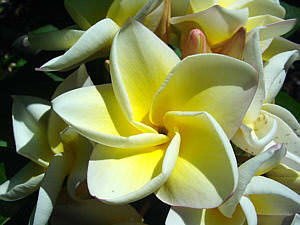Native to Tropical America, from southern Mexico, northern South America and the West Indies, Plumeria is rated a small tree, to about 15-18 feet and is seen in a variety of solid colors. We have seen some Plumeria trees grow much larger
The flowers are about 2 inches long, arranged in 5 petals, are waxy and fragrant. It blooms in spring and through all the summer months
The tree itself is multi-branched and holds thick foliage. The young tree has green wood on the trunk and branches which become more gray as it matures. Seeds look like this...
Plumeria is related to Oleander, Periwinkle and Allamanda
Plumeria has many common names throughout the tropical world including:
- Dead Man's Finger (Australia)
- Jasmine de Cayenne (Brazil)
- Pagoda Tree or Temple Tree (India)
- Egg Flower (southern China)
- Amapola (Venezuela)
Folks who feel their Plumeria requires pruning should wait until the dormant period is well along then cut for shape
Many who grow Plumeria as a houseplant get very upset in the fall and winter months as the leaves start to look sick and fall off one by one. It's natural. Water should be at absolute minimum during all dormant months
This tree prefers full sun or shifting shade and hot weather during blooming months. Not too fussy for soil conditions, Plumeria can grow fairly close to the beach, but without full wind. Enriched soil is preferred and good drainage should be provided
The classic Plumeria is the rubra. Rubra can be found with flowers in various tones of red. Other available varieties include:
- Plumeria alba (white)
- Plumeria obtusa (white with yellow center)
- Plumeria obtusa 'Singapore'
- Plumeria 'Nosegay Frangipani'
- Plumeria rubra 'Tricolor'
The hot new Plumeria in South Florida is the Plumeria pudica. Plumeria pudica blooms as many as 10 months a year and has only partial leaf drop during winter. Foliage is unique as well
New are the dwarf Plumerias. The best one we have seen was planted in a 18-inch terra cotta bowl set on a pedestal. Because of the plant's full leaf habit and many stems, it looked somewhat like a bonsai plant. In the spring and summer, it blooms like the standard Plumeria. With blooms at eye level, the dwarf was a real show stopper



http://mgonline.com/articles/plumeria.aspx










 http://www.balispa.net/frangipani_spa/info.php
http://www.balispa.net/frangipani_spa/info.php